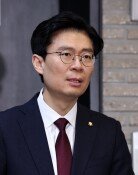Seoul Government Invests in Stem Cell Research
Seoul Government Invests in Stem Cell Research
Posted October. 21, 2005 03:04,
The Seoul city government will invest 19.5 billion won in adult stem cell research for the next five years.
The adult stem cell research is expected to gain full momentum, as the Seoul City jumps on the research bandwagon, followed by the Catholic Seoul Archdiocese.
Seoul announced Thursday that it would create a tentatively named Public Umbilical Cord Blood Bank and Adult Stem Cell Research Center in a new building to be constructed by September 2007, within the municipal Seoul National Boramae Hospital.
The research center will house as many as 200 stem cell researchers from prestigious domestic universities, making it a hub of adult stem cell research. Until the construction of the building is completed, the research will be conducted temporarily in an office on the sixth floor of a recently built building attached to the hospital.
Researchers will carry out research on a variety of incurable diseases, including diabetes, stroke, cardiac infarction, and Parkinsons disease.
It is very significant that the center will be the first umbilical cord bank ever operated by a public institution in Korea.
It will be operated by six colleges which play critical roles in adult stem cell research, such as veterinary and medical colleges of Seoul National University, medical colleges of Korea University, Hanyang University, Catholic University and Sejong University. The research will also be joined by three private biotechnology companies such as ACTS, R&L Bio and Histostem, making it a collaborative effort between industry and academia.
The Seoul city government decided to pour its money into adult stem cell research, mainly because adult stem cell research is not subject to much ethical debate, unlike the embryonic stem cell research led by Hwang Woo-suk, professor of Seoul National University. Moreover, adult stem cell research is likely to be put into practical use sooner than later, with substantial impact on the treatment of incurable diseases.
The center will launch various research projects using cord blood stem cells, including basic research, animal experiments, tests for poison and safety, mass production and clinical tests at the end of this year.
Three years from now, it will start clinical tests focused on several incurable disorders; musculoskeletal disorders such as avascular necrosis osteomatoids; ischemic disorders such as stoke and cardiac infarction; neurological disorders such as spinal paralysis and Parkinsons disease; and diabetes.
With public institutes taking a leadership role in adult stem cell research for the first tem, the umbilical cord blood business is expected to be more officially regulated.
Seoul plans to keep up to 50,000 donated cords in storage at the center by forming a network with hospitals nationwide.
There are a total of 13 private cord blood banks in Korea. Mothers with new-born babies pay an average of 1 million won to keep their umbilical cords at the cord banks. And it costs a patient anywhere between 8 million and 1.5 million won to use cord blood.
The city also plans to provide a certificate, just like a blood donation certificate, to a person who keeps cord blood at the bank, to ensure that the person can enjoy benefits such as a discount in cost for treatment and earlier treatment, if the person contracts a disease which requires cord blood to treat it.
In addition, it will provide cord blood to other patients at less than half the price they currently pay.
Gang Kyung-sun, the professor of veterinary college at Seoul National University who heads its cord blood stem cell research, said, We plan to create an international consortium for cord blood adult stem cell research in collaboration with researchers in the U.S., Britain and Asia. Recently, stem cells, which have the ability to grow into different body parts, have been found in cord blood just as in the case of embryonic stem cells. So we expect that this field will be in the spotlight in the future.
Adult stem cells, which grabbed the attention of researchers earlier than embryonic stem cells, are now being used for the treatment of leukemia and bone-marrow transplants. Researchers are also engaged in clinical tests to use adult stem cells to regenerate brain blood vessels and dead heart muscles.
Jin-Han Lee likeday@donga.com







